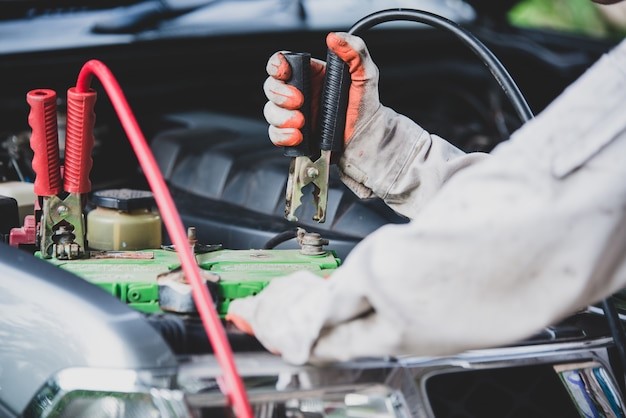How to Fix a Flat Tire Without Calling a Tow Truck: A flat tire can strike at any time, on your way to take your kids to school, while you’re on a weekend road trip, or late at night when you need to get home after some sort of unexpected trouble. When you get a flat tire, your gut reaction is probably to call for a tow truck, but it’ll be a good idea to fix a flat tire yourself when there is no one else to help.
With the proper tools, a few safety tips, and some confidence, however, you can change or repair that tire and be back on the road in no time without waiting or, worse yet, paying for professional help. In this guide, we will explore how to fix a flat tire without calling a tow truck, with step-by-step instructions and tips for staying safe.
Tools & Supplies Needed to Patch a Flat Tire
Before you can begin, you will want to make sure you have the right tools ready. Having these basics in your trunk will make sure you’re prepared when a flat tire does occur.
Essential Tools
- Spare tire or donut: Your car probably has a spare tire or smaller temporary “donut.” Be sure it’s inflated and in good shape.
- Jack: This raises your vehicle off the ground so that you can take the flat tire off.
- Lug wrench: It often takes the form of an “X” or an “L,” and is used to loosen and tighten lug nuts.
- Tire pressure gauge: To ensure your temporary or repaired tire is safe to drive on.
- Flashlight: If your flat is located at night or under low visibility, this is an essential.
- Tire repair kit: Helpful if you want to patch a small hole instead of adding a spare.
You may be short on one or two pieces, but you will be long on self-sufficiency wherever you are on the road.” A short list of road trip essentials: Before taking your car out on the road, take a walk around it.
Safety Comes First Before You Start
Changing a tire on the side of the road can be dangerous, particularly if you’re on the shoulder near traffic or during inclement weather. Don’t forget that your life and the lives of your passengers are the most important things.
Pull Over to a Safe Spot
When you suspect that your tire has lost air, perhaps you hear a thumping sound or feel the car pulling to one side, slow the car down gradually. Don’t slam on the brakes. Find a flat, stable area not in the path of moving traffic, such as a wide shoulder, a parking area, or a rest stop. Don’t stop on soft ground, that will make jacking the car up unsafe.
Activate Flashing Hazard Lights and Deploy Reflectors
Switch on your hazard warning lights to warn other drivers. If you have reflective triangles or road flares, put them 10-15 feet behind your vehicle to help others see you in the dark or fog.
Apply the Parking Brake
When motionless, engage the parking brake forcefully. This keeps your vehicle from rolling and makes work easier.
Step-by-Step Guide to Fix a Flat Tire Without Calling a Tow Truck
Once you finish your safety precautions and your tools are ready to go, you can replace or repair your flat tire.
Step 1. Loosen the Lug Nuts
Before raising the car, you will first need to loosen the lug nuts with your wrench. Turn them counterclockwise. You might work the corks out with your foot or body weight. Don’t take the nuts off completely yet, just loosen it enough that you will be able to unscrew them by hand later.
Tip: The wrench should be held as still as possible, and firm pressure should be applied very slowly, attempting to prevent slipping.
Step 2. Lift the Vehicle with the Jack
Find the recommended jack point for your vehicle (typically near one of the wheels, below the frame). Consult your owner’s manual. Place the jack firmly, then start lifting the car so the flat tire is about 6 inches off the ground. Never place any extremities under the car when it’s raised.
Step 3. Remove the Flat Tire
Continue to unthread the loosened lug nuts all the way, then carefully remove the flat tire straight off the wheel hub. Lay it flat on the ground close by so it doesn’t roll anywhere.
Step 4. Mount the Spare or Use a Repair Kit
Using a spare:
Align the spare tire to the lug bolts and push it onto the hub until flush.
Using a repair kit:
If you don’t have a spare but do have a repair kit. Give close attention to the instructions:
- On plug kits, you insert the plug into the hole, using the tools that come with the kit.
- For sealant cans, screw the nozzle onto your valve stem, apply sealant, then fill your tire to its recommended pressure.
Sealant and plugs are temporary solutions and not for traveling long distances.
Step 5. Tighten the Lug Nuts
Hand-thread the lug nuts to start. And, using your wrench, tighten them in a star or crisscross pattern. This will make sure the wheel sits firmly and properly.
Step 6. Lower the Vehicle and Recheck
Rotate the jack handle slightly to set your vehicle down on the ground again. When the car is on the tire, retighten each lug nut as tightly as possible in the same star pattern. Check and inflate the spare or repaired tire using your tire pressure gauge.
When You Still Might Need Roadside Assistance
Though repairing a flat on your own is an excellent ability, it is not always the right or even possible thing to do:
- You either blow out the tire or have four flats.
- You have no spare tire or repair kit.
- You’re cooped up in dangerous situations, like heavy rain or snow, high-traffic roads with no shoulder, and darkness.
If in doubt, always stay on the side of precaution and call a reputable roadside service like All 4 One Transportation for assistance.
Final Tips to Avoid Flat Tire Problems
Flat tires aren’t entirely preventable, but you can reduce your risk with a few maintenance tips:
- Check tire pressure monthly: Low or underinflated tires Experience more wear and are at risk for damage.
- Avoid potholes and debris: Drive defensively to avoid hazards when applicable.
- Rotate your tires whenever you go in for service, around 5,000–7,000 miles: This provides even wear and extends tire life.
- Store a full flat tire kit in your auto: Add a flashlight, gloves, a tire gauge, and a reflective vest.
A little preparation can save a lot of stress that can result from a flat tire.
Conclusion
You don’t have to sit and wait for a tow truck when your tire’s flat. With the proper tools and a little know-how, you can change or repair your tire in no time and save the cost of a tow truck. Don’t forget: play it safe, don’t feel rushed, and if you can’t do it safely yourself, help is just a phone call away.
Flat tire, locked up in car, out of gas, dead battery, or need a tow, just contact us at All 4 One Transportation Service for 24/7 roadside assistance in Allenhurst, GA, and nearby cities. Stay prepared and stay safe on the road!
FAQs
Donut spare tires are for temporary use only. Drive on it sparingly, not more than 50 miles and not faster than 50 mph, until you can change it to a full-size tire.
No, fix a flat and other sealants only work on small punctures in the tire. A professional repair job is needed on the sidewall damage, or else replace it.
Turn on your hazard lights, pull over to the safest space you can find as far from traffic as is feasible, and call roadside assistance if you’re feeling unsafe. Never try to replace a tire where cars are zipping by you.




